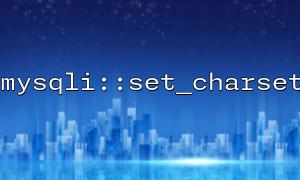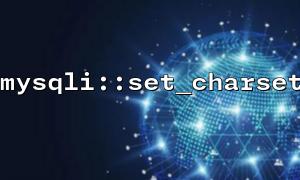When connecting to a database using PHP's mysqli extension, it is often necessary to set the connected character set to ensure the correct read and write of the data. Usually we will use $mysqli->set_charset('utf8') to set the character set. But sometimes, you will encounter an error after calling set_charset , causing the program to fail to execute normally. So, what exactly is the problem? This article will analyze the reasons for the error in setting mysqli::set_charset in combination with common scenarios, and provide troubleshooting ideas.
An error occurred when calling $mysqli->set_charset('utf8') , common prompts include:
Warning: mysqli::set_charset(): Error
Failed to set charset
Garbage characters or data insertion exception
Most of these errors are related to mismatch in character set settings.
The character set settings on the database side are not unified
The character set of the database or data table is inconsistent with the character set of the connection settings.
For example, the default character set of the database is latin1 and the program is set to utf8 . The mismatch between the two may cause an error.
MySQL version or driver limitations
Older versions of MySQL have limited support for certain character sets.
When setting the character set, if the specified character set does not exist or is not supported, an error will be reported.
Character set name error
The character set name passed in set_charset must strictly match the name supported by MySQL.
For example, using utf-8 will make an error, the correct one is utf8 .
The connection is not successful or has been closed
If the $mysqli object does not successfully connect to the database, calling set_charset will also fail.
$mysqli = new mysqli('gitbox.net', 'username', 'password', 'database');
if ($mysqli->connect_error) {
die('Connect Error (' . $mysqli->connect_errno . ') ' . $mysqli->connect_error);
}
Make sure there are no exceptions to the connection before continuing to set the character set.
Query MySQL-supported character sets with the following SQL:
$result = $mysqli->query("SHOW CHARACTER SET");
while ($row = $result->fetch_assoc()) {
echo $row['Charset'] . "\n";
}
Confirm whether the character set you want to set exists, such as utf8 .
When setting character sets, pay attention to case sensitivity and name specifications:
if (!$mysqli->set_charset('utf8')) {
printf("Error loading character set utf8: %s\n", $mysqli->error);
} else {
echo "Current character set: " . $mysqli->character_set_name();
}
Do not use strings like utf-8 .
After logging in to MySQL, check the character sets of the database and tables:
SHOW CREATE DATABASE database_name;
SHOW CREATE TABLE table_name;
If inconsistent, consider modifying the character set of the database or table to avoid conflicts.
Sometimes, you can directly specify the character set when connecting to avoid calling set_charset :
$mysqli = new mysqli('gitbox.net', 'username', 'password', 'database');
$mysqli->query("SET NAMES 'utf8'");
But it is recommended to use set_charset first, because it is safer than SET NAMES .
Mysqli::set_charset setting errors mainly because of incompatible character sets or wrong names. When troubleshooting, make sure:
Database connection is successful
The character set used is correct and supported
The character sets of databases and tables are consistent with the concatenated character sets
By checking the above steps one by one, the problem of errors in setting the character set can usually be solved to ensure that the character encoding of data transmission between PHP and MySQL is correct.
Related Tags:
mysqli




